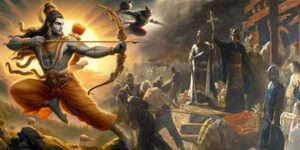Hinduism is the religion where women are honoured as sacred. Lakshmi bestows wealth. Durga vanquishes evil. Yet since the brutal rape of Jyoti Singh in December 2012 there has been a sustained campaign by various organisations to lay the blame of this and other manifestations of sexual violence at the door of Hinduism itself.
 The groups highlighting sexual exploitation in India have their own rather nasty agendas. One could forgive them for blaming Hinduism if in their prejudiced inaccuracy they actually did something positive which long-term would neutralise the epidemic of rape and violence. But then that is not their aim at all. In this shameless exploitation of society’s marginalised and most vulnerable, it is merely another mechanism to be used and then tossed aside when redundant.
The groups highlighting sexual exploitation in India have their own rather nasty agendas. One could forgive them for blaming Hinduism if in their prejudiced inaccuracy they actually did something positive which long-term would neutralise the epidemic of rape and violence. But then that is not their aim at all. In this shameless exploitation of society’s marginalised and most vulnerable, it is merely another mechanism to be used and then tossed aside when redundant.
For example the very ‘secular’ groups and individuals which blame Hinduism for India’s horrific cases of sexual violence, were the very same ones who defended MF Hussain in his misogynist and pornographic depiction of sacred Hindu female figures under the euphemism ‘freedom of expression’. So portrayal of females as sex objects is fine as long as it accords with this amorphous concept? Yet on the other hand it is Hindu portrayal of women as sacred which is blamed for their rape and murder? How can this be the case? It is an absolute absurdity but one we should bare in mind when looking at the latest campaign to highlight sexual violence in India, which once again blames Hinduism for it.
Save the Children is a well respected charity, lauded for its work among the most poverty stricken communities in the poorest countries. This only makes it all the more sad and regrettable that such an organisation of international repute and global standing would resort to cheap and offensive imagery by stirring up religious hatred against Hindus, in order to front its latest campaign in India.
 In response to the sickening rape and murder of Delhi student Jyoti Singh last December, Hindu Human Rights launched its own research into what brought about this monstrous mindset in a country where women have long been worshiped as powerful sacred icons. Indeed women have played a prominent role in Indian history from ancient times, as queens, warriors, military and political leaders. The Rani of Jhansi was in fact only one of many such figures. Women were prominent in fighting for India’s independence. Such long forgotten heroes include Noor Inayat Khan who aided the French Resistance in Word War 2, and was executed in Dachau concentration camp. Women of many backgrounds – Hindu, Muslim, Christian, Sikh, Parsee – have in fact played a prominent and important role in Indian history.
In response to the sickening rape and murder of Delhi student Jyoti Singh last December, Hindu Human Rights launched its own research into what brought about this monstrous mindset in a country where women have long been worshiped as powerful sacred icons. Indeed women have played a prominent role in Indian history from ancient times, as queens, warriors, military and political leaders. The Rani of Jhansi was in fact only one of many such figures. Women were prominent in fighting for India’s independence. Such long forgotten heroes include Noor Inayat Khan who aided the French Resistance in Word War 2, and was executed in Dachau concentration camp. Women of many backgrounds – Hindu, Muslim, Christian, Sikh, Parsee – have in fact played a prominent and important role in Indian history.
But now one ad agency has turned the concept upside down by unveiling a hard-hitting campaign that depicts Hindu deities Lakshmi, Durga and Saraswati as the victims of domestic abuse. These shocking images are meant to highlight cases of domestic abuse, sexual exploitation and people trafficking. The text accompanying the shocking images reads:
‘Pray that we never see this day. Today, more than 68 per cent of women in India are victims of domestic violence. Tomorrow, it seems like no woman shall be spared. Not even the ones we pray to.’
According to Save the Children India, which commissioned the images to promote its Save Our Sisters anti-trafficking initiative, trafficking of young girls and women for sexual exploitation is all too common.
A long with campaigning, the charity hopes to tackle the problem through its Sahas Kendra Livelihood Programme, which helps victims of trafficking to overcome their experiences through counselling while also providing them with education and life skills needed to keep them off the streets. These initiatives are supported by Beulah London founder Lady Natasha Rufus-Isaacs who has seen the plight of India’s exploited women and girls first hand:
long with campaigning, the charity hopes to tackle the problem through its Sahas Kendra Livelihood Programme, which helps victims of trafficking to overcome their experiences through counselling while also providing them with education and life skills needed to keep them off the streets. These initiatives are supported by Beulah London founder Lady Natasha Rufus-Isaacs who has seen the plight of India’s exploited women and girls first hand:
We fully support the Abused Goddesses campaign, and its aim to raise awareness of human trafficking. The imagery is powerful and moving, and we hope it will help prevent and protect many women from being trafficked in the future.’
So they FULLY SUPPORT, yes that is Beulah’s very own words, this vilification campaign against the sacred feminine in Hinduism. Perhaps there is more to this as Lady Natasha also says:
‘It’s one of the largest crimes in our society today – more so than trafficking drugs. Drugs can be sold once but human beings can be sold over and over again, it is an extremely lucrative market.’
So this is a LUCRATIVE market? What else is ‘lucrative’ in this context? Well it turns out that the very charity backing this campaign has a few skeletons in its own rather dirty cupboard.
In August 2003 Conservative MP Priti Patel revealed that leading charities were paying their bosses incredibly generous pay packets. Despite falling donations, 11 bosses at the  14 charities which make up the Disasters Emergency Committee are now paid more than the Prime Minister’s £142,500. Among the names listed, one finds Save the Children. In fact Justin Forsyth earns £163,000 as its chief executive. Indeed its executives shared a nice £160,000 bonus pot. Yet Save the Children is unapologetic.
14 charities which make up the Disasters Emergency Committee are now paid more than the Prime Minister’s £142,500. Among the names listed, one finds Save the Children. In fact Justin Forsyth earns £163,000 as its chief executive. Indeed its executives shared a nice £160,000 bonus pot. Yet Save the Children is unapologetic.
Is that why it has resorted to anti-Hindu defamation to recover its tarnished image? Let us ask ourselves, why target Hindu goddesses? Why not the sacred imagery of other religions? If it is because India is a Hindu-majority country, then does that not go against the constitutional ethos of a secular and all-inclusive India? Is it only Hindu women and girls that are the targets of domestic violence, dowry extortion, gender related infanticide, and sex trafficking? What about the underage girls sold as concubines and sex slaves to wealthy buyers, yes buyers, in the Gulf?
 What about the rampant abuse in Catholic orphanages, not just in India but in western countries notably Australia and Ireland, which are only just beginning to be uncovered? Why should a campaign against sexual exploitation and violence leave out so many Indians just because they are not Hindu?
What about the rampant abuse in Catholic orphanages, not just in India but in western countries notably Australia and Ireland, which are only just beginning to be uncovered? Why should a campaign against sexual exploitation and violence leave out so many Indians just because they are not Hindu?
So as well as indulging in what amounts to hatred against Hinduism, Save the Children and Save Our Sisters has also ignored the plight of millions of non-Hindu victims in its latest badly thought out campaign. It is therefore in a unique situation of not only vilifying Hindus, but also vilifying non-Hindu sex trafficking and domestic violence victims by removing them from the direct remit of its much-publicised hard-hitting campaign. Just ask yourself, would a respected charity of global standing exploit and abuse the sacred imagery if that targeted religion was not Hinduism? Has this well-respected organisation and its ignorant followers even done so in the past?
 Admittedly these are rhetorical questions but necessary to demonstrate the double standards once again at work here. Yet most poignant of all is not even the fact that Save the Children needs to scrape the bottom of a very dirty anti-Hindu barrel simply to market its prejudicial and discriminatory campaign. It is the fact that despite all this it will make scant impact. It will be forgotten and the sexual exploitation will continue as before.
Admittedly these are rhetorical questions but necessary to demonstrate the double standards once again at work here. Yet most poignant of all is not even the fact that Save the Children needs to scrape the bottom of a very dirty anti-Hindu barrel simply to market its prejudicial and discriminatory campaign. It is the fact that despite all this it will make scant impact. It will be forgotten and the sexual exploitation will continue as before.
That is because very little effort is being made to change mindsets, because if that did happen this international business would not be needed. It would be irrelevant. it would not be able to justify levels of pay that stand in nauseating contrast to the poverty-stricken communities that Save the Children claims to be helping. I say business, because that is what it is.
A business, a commercial concern, a money-making machine like any other. Just as negative imagery of Africans was once used, notably the notorious golliwog on Robinson jam and marmalade, so now Save the Children uses the vilification of Hindus as its cheap marketing gimmick. Just like the golliwog this has its roots in a racist and colonialist mindset which unfortunately is very much alive when it comes to Hindus.
Despite the horrific levels of domestic violence, dowry abuse, people trafficking and other forms of gender and sexual exploitation, why are the large Hindu organisations so quiet? When it comes to having buffet dinners in parliament or meeting VIPs they are always there waiting like pigeons begging for a few crumbs at the picnic table.
How many charred remains of young brides involved in ‘kitchen accidents’ with kerosene and matches are needed to stir the lack of conscience exhibited by the Hindu organisations which run like shoe-shine boys after politicians and business leaders? Why have the major Hindu organisations not spoken out?
Of all the belief systems Hinduism has positive female role models in the form of swaminis, female ascetics who have thousands even millions of male followers. Mata Kali is portrayed as dancing over the body of Shiva. How then can Hinduism be constantly berated as misogynist? Why are the female role models, both deified and the very human ones of warrior-queens and latter day freedom fighters ignored in this entire discourse surrounding sexual violence? The fault of this cannot be found with Hindu-baiting groups like Save the Children. The fault lies with Hindu organisations and leaders who have lost not just their moral compass, but their very relevance. They have made themselves redundant.































